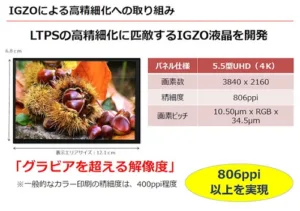The Korean government has initiated a project called EnDK, which aims to develop a mobile display with 11k resolution and 2,550 ppi. That would be, roughly, a 5.9″ screen with 11520 x 6480 resolution.
The world’s current highest-density display is Sharp’s 5.5″ UltraHD IGZO screen, with 806 ppi (Sharp UltraHD Mobile Display – Yes)Samsung Display is working with 13 other companies on the project, which is expected to last five years. EnDK will be funded by a $26.5 million grant. A prototype is expected to be shown by the time of the 2018 Pyeongchang Winter Olympics in Korea.
The human eye cannot physically recognise resolutions much higher than 2560 x 1440 on a smartphone display. However, Samsung says that the ‘super dimension’ screen would enable an optical illusion that would create 3D images. It may have uses in VR applications.
No details, such as the screen technology, were shared.
Analyst Comment
Since the introduction of HD displays (that would be 720p of course) into smartphones, many have seen FHD displays in smartphones just as overkill. Nevertheless, today’s smartphones typically come with HD and FHD panels, with some larger models also pushing QHD (also called 2K) resolution. It was certainly a necessity to increase panel resolution from the VGA type phone displays used in the early 2000’s to this kind of resolution, as all of us can easily see the difference between a display from then and today. Now, there are also differences in brightness and color saturation to consider, but I am sure that almost everyone will agree with this sentiment.
However, I am not so sure that many will see the same difference when they see an actual comparison between a QHD panel and the proposed 11K one.
During the rise of the smartphone and tablet for that matter, many marketing people have learned that pixels sell devices. As a consequence, they see an absolute benefit in pushing the envelope on display panel resolution as it gives them a valuable advantage in the market.
During the same time frame, Apple has introduced the term ‘Retina’ display as a concept describing a display that provides as much information as our vision system is capable of resolving. While not all agree with the definition as used by Apple, the basic concept still applies. In addition, a catchy technical term that can also be trademarked helps the heart of every marketing executive beat faster.
Of course, the consequence of the Apple terminology is also that there is actually a point where more pixels do not make any sense, a point that is certainly passed with an 11K display in a 5.1″ smartphone. From this perspective, this whole concept seems rather useless.
However, there are other aspects to this development effort. First of all, South Korea has always been keen on bringing and keeping its display manufacturers above the competition. Government-sponsored development has been one of the drivers used before. This particular development may help the Korean companies on several levels.
First of all, learning to make a 2,550 ppi display in over 5″ sizes will give them a boost in manufacturing technology at the least. No matter, what display technology they will be exploring there is a significant technology development required to get close to this pixel density in larger display sizes. So far the 2,000 ppi range is solely occupied by microdisplays.
There is also a future demand for super high resolution displays in virtual and augmented reality devices. By the time these displays may become available, these applications may be looking for exactly this kind of display technology. – NH

